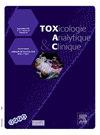使用高分辨率精确质量(HRAM)轨道阱质谱法定量含四氢大麻酚的口服液药物组
IF 1.8
Q4 TOXICOLOGY
引用次数: 0
摘要
目的开发一种HRAM LCMS方法,用于口服液中31种滥用药物的定量分析,并具有完整的样品制备工作流程,满足国家安全委员会提出的截止水平。这31种分析物分别是:6-氨基氯硝西泮、7-氨基氯硝西泮、阿普唑仑、安非他明、苯甲酰冈碱、丁丙诺啡、卡异丙醇、氯硝西泮、可卡因、可待因、地西泮、芬太尼、氢可酮、氢吗啡酮、劳拉西泮、丙二醛、MDMA、丙氨酸酯、美沙酮、甲基苯丙胺、吗啡、诺地西泮、奥西泮、羟考酮、羟吗啡酮、PCP、替马西泮、四氢大麻酚、曲马多和唑吡坦。方法将31种目标分析物的原液加入人口服液中,建立9个标准浓度(0.5 ~ 1000 ng/mL)。用保存缓冲液稀释样品,并加入相应的内标。采用DPX INTip™SCX/WAX固相萃取法提取各样品500 μL。使用Thermo Scientific™Accucore™联苯柱连接到Thermo Scientific™Vanquish™Horizon UHPLC系统,使用快速7分钟方法分离药物分析物。使用数据依赖MS2模式(ddMS2)在Thermo Scientific™Orbitrap™Exploris™120质谱仪上获取数据,包含31种靶药物。使用Thermo Scientific™TraceFinder™5.2软件进行数据采集和处理。结果31种药物的定量限(LOQ)均低于新的SAMHSA指南截止值,从低至0.5 ng/mL到最高检限(ULOL)为1,000 ng/mL均呈线性关系。THC δ -9的定量限为1 ng/mL。所有药物均确认质量准确度小于5ppm,保留时间和文库匹配。这项研究还能够克服一些与四氢大麻酚相关的常见问题,包括药物对消耗品的“粘性”以及对口服液体收集装置缓冲液抑制的敏感性。结论该方法适用于SAMHSA和国家安全委员会规定的31种滥用药物。给出了用DPX INTip固相萃取法制备样品的完整流程。从定量限低至0.5 ng/mL到1000 ng/mL均实现线性,这说明了这些仪器和提取程序的灵敏度。这种快速、灵敏的口腔液体检测方法充分通过了SAMHSA的指导方针。本文章由计算机程序翻译,如有差异,请以英文原文为准。
Quantitation of an oral fluid drug panel including THC using High Resolution Accurate-Mass (HRAM) orbitrap mass spectrometry
Aim
To develop a HRAM LCMS method for quantitative analysis of 31 drugs of abuse in oral fluid with a complete sample preparation workflow that satisfies cutoff levels presented by the National Safety Council. The 31 analytes are as follows:
6-MAM, 7-aminoclonazepam, Alprazolam, Amphetamine, Benzoylecgonine, Buprenorphine, Carisoprodol, Clonazepam, Cocaethylene, Cocaine, Codeine, Diazepam, Fentanyl, Hydrocodone, Hydromorphone, Lorazepam, MDA, MDMA, Meprobamate, Methadone, Methamphetamine, Morphine, Nordiazepam, Oxazepam, Oxycodone, Oxymorphone, PCP, Temazepam, THC, Tramadol, and Zolpidem.
Method
Nine calibration levels (ranging from 0.5 to 1000 ng/mL) were made by spiking stock solution of the 31 target analytes into human oral fluid. Samples were diluted with a preserving buffer and spiked with their corresponding internal standard. 500 μL of each sample were then extracted using DPX INTip™ SCX/WAX SPE. Drug analytes were separated with on a Thermo Scientific™ Accucore™ Biphenyl column connected to a Thermo Scientific™ Vanquish™ Horizon UHPLC system using a fast 7-minute method. Data was acquired on the Thermo Scientific™ Orbitrap™ Exploris™ 120 mass spectrometer using data dependent MS2 mode (ddMS2) with an inclusion list for the 31 target drugs. Thermo Scientific™ TraceFinder™ 5.2 software was used for data acquisition and processing.
Results
Limits of quantitation (LOQ) determined for the 31 drugs were all below the new SAMHSA guidelines cutoffs and linearity was achieved from as low as 0.5 ng/mL to a ULOL of 1,000 ng/mL. THC delta-9 achieved an LOQ of 1 ng/mL. All drugs were confirmed with mass accuracy of less than 5 ppm, retention times, and library matching. This study was also able to overcome some of the issues commonly associated with THC including “stickiness” of the drug to consumables and its susceptibility to being suppressed by oral fluid collection device buffers.
Conclusion
This fast and quantitative method was developed around 31 drugs of abuse specified by SAMHSA and the National Safety Council. A complete workflow was presented that involved sample preparation using DPX INTip SPE. Linearity was achieved from LOQ's as low as 0.5 ng/mL up to 1000 ng/mL which exemplifies the sensitivity of these instruments and extraction procedure. This fast and sensitive method for oral fluid testing sufficiently passes the SAMHSA guidelines.
求助全文
通过发布文献求助,成功后即可免费获取论文全文。
去求助

 求助内容:
求助内容: 应助结果提醒方式:
应助结果提醒方式:


